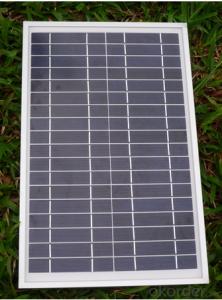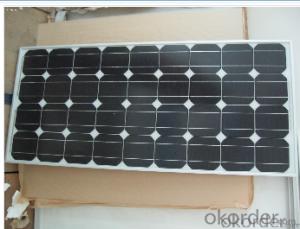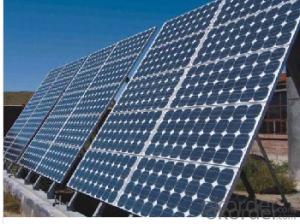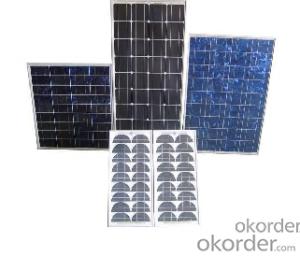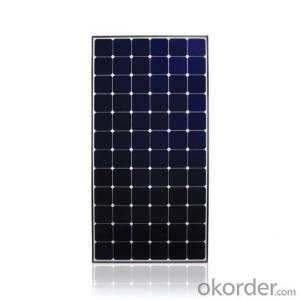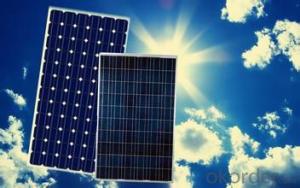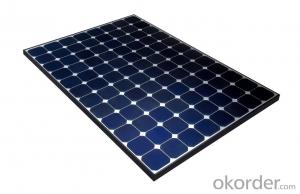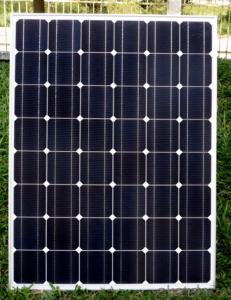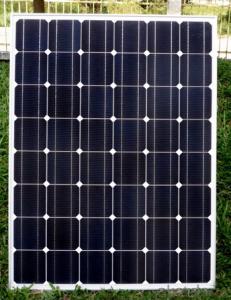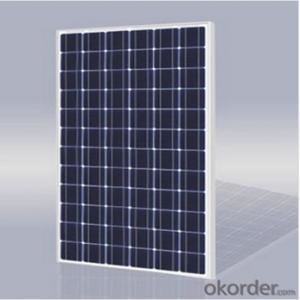Dallas Solar Panels 1.5w CNBM Monocrystalline Silicon Panel for Home Use
- Loading Port:
- Tianjin
- Payment Terms:
- TT OR LC
- Min Order Qty:
- 26 watt
- Supply Capability:
- 1000 watt/month
OKorder Service Pledge
OKorder Financial Service
You Might Also Like
Specification
1.5W CNBM Monocrystalline Silicon Panel for Home Using
Production description
Solar energy is radiant light and heat from the Sun harnessed using a range of ever-evolving technologies such assolar heating, photovoltaics, solar thermal energy, solar architecture and artificial photosynthesis.
It is an important source of renewable energy and its technologies are broadly characterized as either passive solar oractive solar depending on the way they capture and distribute solar energy or convert it into solar power. Active solar techniques include the use of photovoltaic systems, concentrated solar power and solar water heating to harness the energy. Passive solar techniques include orienting a building to the Sun, selecting materials with favorable thermal mass or light dispersing properties, and designing spaces that naturally circulate air.
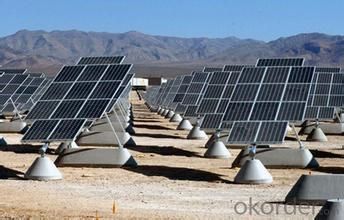
Feature
1.High conversion efficiencies resulting in superior power output performance.
2.Outstanding power output even in low light or high temperature conditions
3.Optimized design for ease of soldering and lamination
Physical characteristic
1. Rigorous quality control meets the highest international standards.
2. High-transmissivity low-iron tempered glass, strong aluminium frame.
3. Using UV-resistant silicon.
4. IS09001/14001/CE/TUV/UL
- Q: What is the difference between monocrystalline and polycrystalline solar panels?
- Monocrystalline solar panels are made from a single crystal structure, typically silicon, which results in a higher efficiency and sleeker appearance. Polycrystalline solar panels, on the other hand, are made from multiple silicon fragments, making them less efficient but more cost-effective.
- Q: Can solar panels be installed on a boat?
- Yes, solar panels can be installed on a boat. In fact, it is a popular and efficient way to generate electricity for various onboard systems, such as lighting, navigation, and charging batteries. Solar panels are lightweight, durable, and can be easily mounted on the deck or roof of a boat to harness solar energy and contribute to a more sustainable boating experience.
- Q: i have a calculator with a solar panel what could i power with it? like could i hook it up to a psp even though it will take forever to charge? and how would i do this?
- All stable suggestions, yet you like 2 AA cells to keep the skill from the image voltaic panel to coach at ineffective night. The calculator probable has 2 or 3 rechargeable button cells. I somewhat have chanced on that non rechargeable Energizer or Duracell alkaline AA cells artwork sensible in those exterior/exterior LED lighting fixtures furniture furniture, so as which you would be waiting to recharge between short heating classes with an incandescent or a LED a lot longer. it is going to take distinctive days to recharge a pair of rundown AA with one calculator panel, so as which you will desire to decide utilising 2 or extra beneficial panels (in sequence if the calculator in simple words has one button cellular). 2 photograph voltaic panels in sequence from exterior LED lighting fixtures furniture furniture, could desire to recharge your AA cells in some hours of staggering photograph voltaic. I somewhat have 2 exterior lighting fixtures furniture furniture I keep charged via putting them the incorrect way up (without the stake and, defuser globe) on appropriate of CFL bulbs, one in each and every of that's 0 watts = forty watt equivalent. Neil
- Q: Are there any free classes to learn about solar energy and building a solar panel
- Why don't you just call a solar energy company and ask them anything you need to know, or check out websites- they usually have page with faqs or info. The company I used has lots of info on their website and they were very helpful.
- Q: Can solar panels be used to power a military vehicle?
- Yes, solar panels can be used to power a military vehicle. Advances in technology have allowed for the development of lightweight and flexible solar panels that can be integrated into the structure of military vehicles. These solar panels can capture sunlight and convert it into electrical energy to power various systems and reduce reliance on traditional fuel sources. Implementing solar panels can enhance the sustainability and operational efficiency of military vehicles in certain scenarios.
- Q: I'm a student trying to design a mounting structure for solar panels. I'm reading about passive trackers so as to track the sun for optimal energy production; but I am not fully quot;seeinghow it works. Can someone please help explain it to me, or at least send me a link(s) that could help explain it well?THANKS IN ADVANCED!! [and HAPPY HALLOWEEN!!]
- It appears to be relying upon a phase change of liquid to gas to liquid to balance the system and return it to the east in the morning.
- Q: i want to know how to hook up solar panels to my existing power. all i can find on the internet is to use batteries and a inverter. but i want to use all of my existing lights and outlets off of the solar energy. i have heard that you can actually turn the meter backwards and use supplied power when needed. thats what i want to do and is it possible to do myself and if so, how?
- Im an ex solar installer. I dont know all the details but I know of 2 companies in hawaii that are doing what youre talking about - and yes, it feeds power back into the grid and makes your meter turn backwards. uh... darn... locate a company that does that stuff and they will tell you best how and what and why. The electric comapny will know less as they are (believe it or not) behind the times. 2st century technologies is the co. in hawaii. the owner is way cool. its a full-on expensive system though, not some cheesy diy thing. its gnarley. you need the special panels and all that. Photovoteic panels are really expensive. The system costs like 0k + but pays for itself after perhaps 6 years and then you reap the monthly check from the electric company for life (instead of you paying them) Inh hawaii, the sun is strong = $$$ for solar. good luck in your....quest? whatever, man. Hope you find what youre looking for.,
- Q: Can solar panels be installed on public transportation systems?
- Yes, solar panels can be installed on public transportation systems. In fact, many cities around the world are increasingly integrating solar panels onto buses, trams, and trains to harness clean energy and reduce carbon emissions. These panels can be installed on the roofs or sides of vehicles, enabling them to generate electricity and contribute to the power needs of the transportation systems.
- Q: Im looking at making a self build iPad solar panel charger, Is it possible to get a small solar panel, a battery to hold charge and then a USB output? nothing fancy, just power in and power out?
- Sure it is possible. There are even commercial products that do that. I have a solar cell phone charger. But it is not able to fully charge the phone battery. I am not sure why but I suspect the voltage it puts out is too low. In other words, it is a poor design. It is certainly possible to make a better design, but maybe not easy. You can damage a battery by over charging it, so just increasing the voltage is not the solution. You need just the right voltage and current.
- Q: I am planning to run a couple of dc motors on solar current. I have a couple of 450mA 4V, 200mA .5V, 00mA 9V solar panels with me. I need to run a pair of .5A 9V motors. Suggest me a circuit along with other equipments I might require. For your info, I am trying to build a solar powered drone / UAV
- I don't think it is enough solar power. Your motor requires .5A x 9V = 3.5 watts. The solar cells are .450A x 4V x 2ea. = 3.6 watts, .2A x .5V = .3 watts, .A x 9V = .9 watts total solar = 4.8 watts. The problem with connecting the cells in series to get the right voltage, like the two 4V cells in series with the .5 volt cell (total 9.5 volts) is that the .5 volt cell limits the maximum current to only 0.2A. If you paralleled that with the 9V cell, you would get 9 volts at 0.2 + 0. = 0.3A, too low to operate the motor at its design current and voltage. The best you could do is put the two 4V cells in series, and in parallel with the 9V cell (a blocking diode might be a good idea, but probably not required for such a small array). That way you get 8 volts at 0.55 amps.
Send your message to us
Dallas Solar Panels 1.5w CNBM Monocrystalline Silicon Panel for Home Use
- Loading Port:
- Tianjin
- Payment Terms:
- TT OR LC
- Min Order Qty:
- 26 watt
- Supply Capability:
- 1000 watt/month
OKorder Service Pledge
OKorder Financial Service
Similar products
Hot products
Hot Searches
